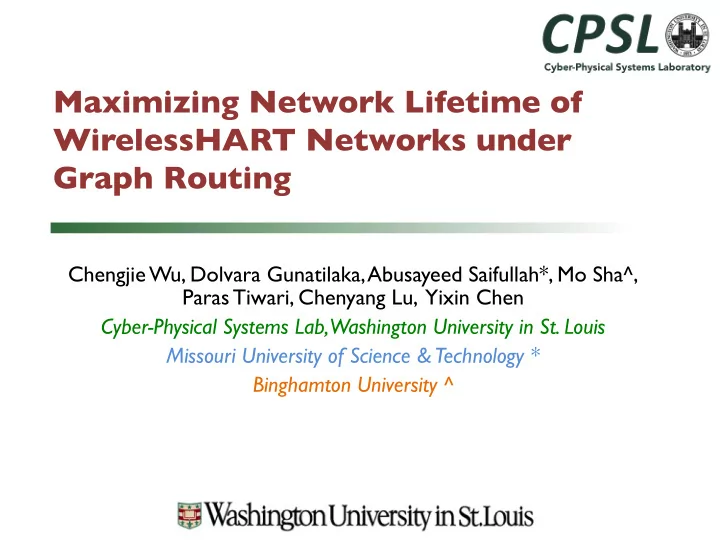

Maximizing Network Lifetime of WirelessHART Networks under Graph Routing Chengjie Wu, Dolvara Gunatilaka, Abusayeed Saifullah*, Mo Sha^, Paras Tiwari, Chenyang Lu, Yixin Chen Cyber-Physical Systems Lab, Washington University in St. Louis Missouri University of Science & Technology * Binghamton University ^
Wireless for Process Automa1on Emerson • 5.9+ billion hours operating experience • 26,200+ wireless field networks Offshore Onshore $944.92 million by 2020 [Market and Market] Courtesy: Emerson Process Management Killer App of IoT! 2
Industrial Wireless Challenges Ø Reliability Sensor Ø Real-time Ø Control performance Actuator Ø Energy efficiency: need long battery life in sensor data harsh environments! control command Controller 3
WirelessHART Ø Industrial reliability q Multi-channel TDMA MAC q Over IEEE 802.15.4 PHY q Redundant routes Ø Centralized network manager q collects topology information q generates routes and transmission schedule Industrial wireless standard for q disseminates to field devices process monitoring and control q re-computes routes when topology changes 4
Graph Rou1ng Ø Handle link and node failures through path diversity Ø Graph route of a flow q a primary path q a backup path for each node on the primary path w 5 7 primary path 1, 2 3, 4 5, 6 d s u v backup path 7 3 8 4 5 x y z Ø Transmissions per hop q Two transmissions on the primary link – dedicated TDMA slots q One transmission on the backup link – shared CSMA/CA slot 5
Energy Cost of Reliability Ø Graph routing improves reliability at cost of energy Ø Measurement: +57% reliability at 1.7 × energy compared to single-path source routing [EWSN'15] Graph routing: 88% Source routing: 31% 6
Challenges Ø Maximize network lifetime under graph routing q Industry demands multi-year battery life q Efficient routing in response to wireless dynamics Ø Unique challenges for WirelessHART networks q Centralized multi-path graph routing q Transmissions in dedicated and shared slots 7
Contribu1ons Ø Problem: network lifetime maximization under graph routing q Network lifetime = time till first node runs out of battery q NP hard Ø Three approaches q Optimal integer programming q Linear relaxation of the integer programming q Efficient greedy heuristic Ø Implementation on a WirelessHART testbed 8
Analyzing Power Consump1on Ø Model based on WirelessHART standard Ø 1-2 transmissions on primary path Ø 3 rd transmission on back path q Small probability, but receiver must turn on and listen. Ø Load : power consumption / battery capacity w 5 7 primary path 1, 2 3, 4 5, 6 s u v d backup path 7 3 8 4 5 x y z 9
Integer Programming Ø Objective: max min node lifetime à min max load Ø Graph route as constraints q An incoming primary link à an outgoing primary link q An incoming primary link à an outgoing backup link q An incoming backup link à an outgoing backup link w 5 7 primary path 1, 2 3, 4 5, 6 d s u v backup path 7 3 8 4 5 x y z Ø Optimal solution Ø High computational cost à cannot scale to large networks 10
Linear Programming Relaxa1on 1. Relax binary decision variables to real numbers 2. Linear Programming à real number solutions 3. Round real numbers to integer solutions based on threshold 4. Incrementally find the largest threshold with valid routes Ø Implemented in GNU Linear Programming Kit (GLPK) Ø Near optimal solution with affordable computational cost. 11
Greedy Heuris1cs Ø Compute routes for flows in the rate monotonic order Ø For each flow: find the graph route with minimum load q Load per node = power consumption / battery capacity q Incrementally add nodes with the smallest load to primary path and update neighbors’ load q Then select backup path with minimum load d Ø Iterate until no further improvement b c Ø Polynomial complexity s e f 12
Evalua1on Ø Implemented on a WirelessHART testbed (69 TelosB motes) q WirelessHART stack (multi-channel TDMA + routing) q Network manager (scheduler + routing ) Ø Simulations based on testbed topology WUSTL wireless sensor-actuator network testbed 13
Compare to Op1mal (Small Network) • Lifetime normalized to optimal solution from Integer Programming • 10 nodes, 20 links • SP : Shortest Path • RRC [Han 2011] • GH : Greedy Heuristic • LP : Linear Programming GH & LP within 80% of optimal 14
Network Life1me (Testbed Topology) LP and GH lead to longer network lifetime 15
Execu1on Time (Testbed Topology) GH needs less time than LP 16
Conclusion Ø Industrial wireless networks is a killer app for IoT q Driven by industrial standards such as WirelessHART q Deployments rolling out world wide Ø Graph routing enhances reliability at high energy cost à energy efficiency is critical! Ø Three approaches to maximize network lifetime q Integer Programming: optimal q Linear Programming Relaxation: faster q Greedy Heuristic: fastest solution for run-time adaptation Ø Implemented with WirelessHART on testbed 17
Reading Ø C. Wu, D. Gunatilaka, A. Saifullah, M. Sha, P .B. Tiwari, C. Lu and Y. Chen, Maximizing Network Lifetime of WirelessHART Networks under Graph Routing, IEEE International Conference on Internet-of-Things Design and Implementation (IoTDI'16), April 2016. 18
Recommend
More recommend